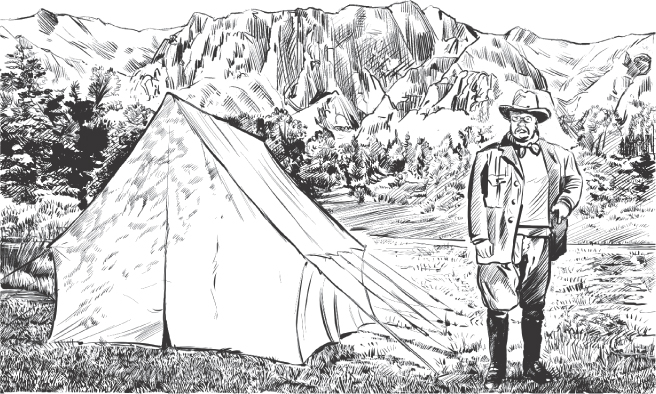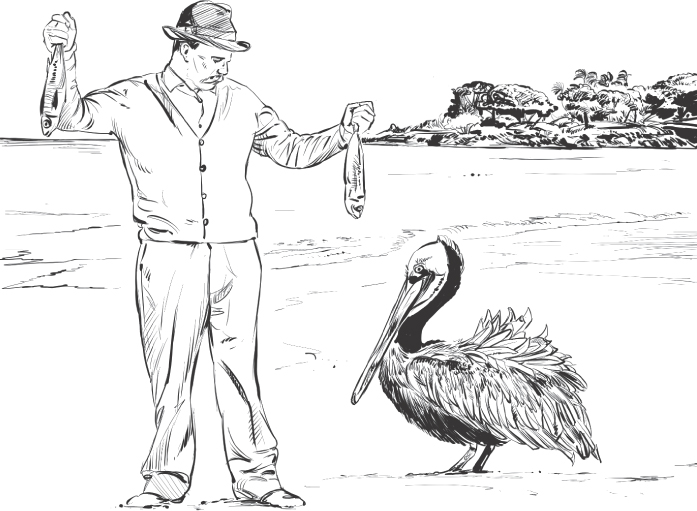
Being president brought Theodore Roosevelt many happy moments. Some of his greatest successes were on an issue that was close to his heart—the environment. Years spent in the country’s forests and plains had taught him that animals and land needed to be protected. Even though he enjoyed hunting, Roosevelt agreed with laws that limited where and what a person could hunt and kill. He also knew that those laws were not always enforced. During his travels, he had seen firsthand how the spread of railroads and other businesses threatened the land and the wildlife that lived there.


In 1894, while serving on the Civil Service Commission, Roosevelt had fought to protect Yellowstone National Park in Wyoming. Even though it was already a national park, laws allowed for partial destruction of the Yellowstone land by railroads and mining. He pushed for a new law that would keep businesses and industry out of Yellowstone. Roosevelt also saw the danger of pollution to streams and lakes and the wildlife that lived near them. As governor of New York, he had called for laws to limit pollution in the state.
As president, Roosevelt made protecting the environment of the entire country one of his biggest priorities. He believed in conservation—saving the country’s natural resources: land, air, water, and wildlife. President Roosevelt helped create five new national parks and preserve 150 national forests. By setting aside this land and allowing the federal government to control it, he ensured that no further development or destruction could take place there. He also created national monuments, such as Arizona’s Petrified Forest. He did more than any president before him to protect the environment.

ONE OF THE SITES ROOSEVELT NAMED A NATIONAL MONUMENT DURING HIS PRESIDENCY WAS THE GRAND CANYON IN NORTHERN ARIZONA. IT STRETCHES EIGHTEEN MILES ACROSS AT ITS WIDEST POINT AND IS MORE THAN A MILE DEEP. ROOSEVELT VISITED THE GRAND CANYON IN 1903 AND WAS AWED BY IT. IN A LETTER HOME TO ETHEL, HE CALLED IT “WONDERFUL AND BEAUTIFUL BEYOND DESCRIPTION. I COULD HAVE SAT AND LOOKED AT IT FOR DAYS.” TODAY THE GRAND CANYON IS A NATIONAL PARK—AN AREA OF SPECIAL SCENIC, HISTORICAL, OR SCIENTIFIC IMPORTANCE SET ASIDE AND MAINTAINED BY THE NATIONAL GOVERNMENT. MORE THAN FOUR MILLION PEOPLE VISIT IT EACH YEAR.
Roosevelt also wanted trained people taking care of the public lands, to reduce the risk of forest and brush fires. Now called rangers, they also made sure hunters killed no more than the number of birds and animals allowed by law. And when Congress wanted to let business cut more timber in the West, Roosevelt acted quickly. In 1907 he issued an order to protect millions of acres of forests before Congress could pass a law that might have destroyed them.
One of his conservation efforts came at the urging of Frank Chapman, who worked at the American Museum of Natural History. Chapman was the museum’s ornithologist—an expert on birds. He knew that Roosevelt had loved and studied birds, since as a teen “Teedie” had donated some of his own birds to the museum. Roosevelt’s father, Theodore Sr., had helped create the American Museum of Natural History in New York in 1869.

Chapman now hoped that President Roosevelt would support his idea to create a protected area for birds, called a sanctuary, off the coast of Florida. Roosevelt learned there was no law that stopped him from simply creating the sanctuary on his own. So, he created Pelican Island National Wildlife Refuge, the first of fifty-three bird sanctuaries that he would ultimately create. In 2012 the American Museum of National History honored Theodore Roosevelt’s contributions to the conservation effort. It unveiled a new statue of Roosevelt, showing him as he looked on a camping trip to Yellowstone in 1903. He had said that year, “We are not building this country of ours for a day. It is to last through the ages.”